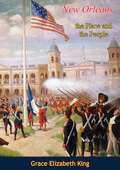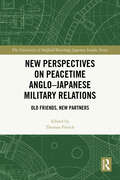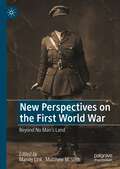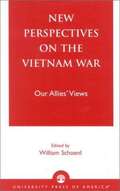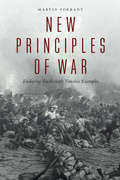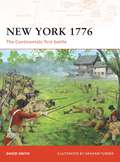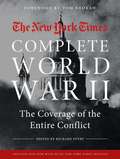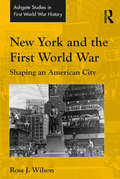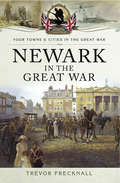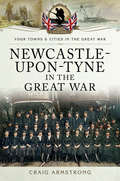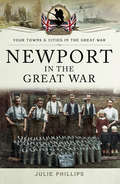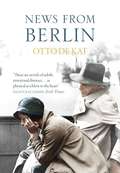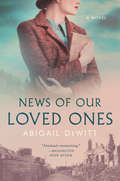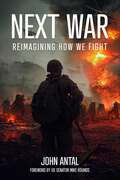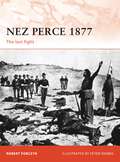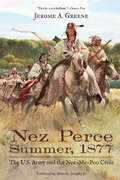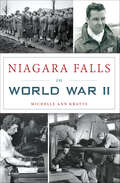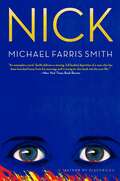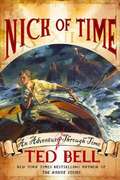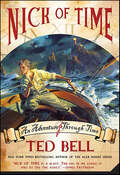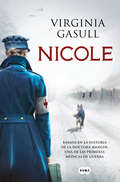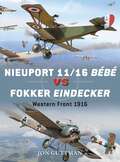- Table View
- List View
New Orleans the Place and the People
by Grace Elizabeth KingThe work presented here is a popular history of New Orleans published in 1895 and covering the entire history of the city down to that date. It is written in a vivid, discursive style.Not as well-known as some of her contemporaries—Mark Twain, George W. Cable, and Joel Chandler Harris, to name a few—author and historian Grace King (1851- 1932) was nonetheless highly praised in her own right. She garnered attention from such eminent critics as William Dean Howells, and her work frequently appeared in Harper's and Century Magazine. She published thirteen volumes of fiction, history, biography, and memoir. What contributed to King's critical acclaim, and her continued importance across time, was the panoramic view of social and historical New Orleans that she captured in her writing. She was, scholar Robert Bush argues, one of the most talented and perceptive citizens of New Orleans during the post- Civil War period. In pursuing an intellectual career, King broke with many Old South traditions. She embraced Anglo-Saxon and Creole French cultures. Much of her work is especially interesting for the way in which her view of the southern temper and cultural contribution supplemented that of other writers of the period.-Print ed.
New Perspectives on Peacetime Anglo–Japanese Military Relations: Old Friends, New Partners (The University of Sheffield/Routledge Japanese Studies Series)
by Thomas FrenchThis book examines the peacetime military relationship between the United Kingdom and Japan spanning partnerships and interactions from the 1860s to the present day.Reflecting the multiple changes in the power dynamics, relations, and nature of the military links between the U.K. and Japan over time, the chapters in this book analyse instances of peacetime military interaction as both countries passed through periods of partnership, alliance, rivalry, conflict, and occupation. In doing so, the book also considers what relevance these historical U.K.– Japan peacetime military ties have relevance for those of the present.Original in its exclusive focus on peacetime military links of both a historical and contemporary nature, this significant work is both practical and scholarly in its approach and will appeal to students and scholars of Japanese history, British history, military history, international relations, and diplomacy.
New Perspectives on the First World War: Beyond No Man’s Land
by Matthew M. Stith Mandy LinkTaken collectively, the chapters in New Perspectives on the First World War: Beyond No Man’s Land not only illuminate pieces of the Great War that remain in the shadow of the broader narratives, but also, and more importantly, foster new perspectives, pose distinct questions, and suggest fresh directions from which future work might emerge. Transnational approaches, the cultural and environmental history of war, and gender’s ubiquitous but heretofore marginalized role in the larger conflict together merit fresh research and careful new interpretation.
New Perspectives on the Vietnam War: Our Allies' Views
by William SchoenlThis volume presents excerpts of longer historical works that examine the reactions of the U.S.'s South Asia Treaty Organization allies to the war in Vietnam and their role in resisting or supporting the U.S.'s goals. The works have been edited to present a continuous story from the escalations of Lyndon Johnson to the final years of the conflict. The involvement of Asian ally troops, the opposition of Pakistan, British and French reactions, and the gradual pulling away of Australian involvement are the major topics covered.
New Principles of War: Enduring Truths with Timeless Examples
by Marvin PokrantInfluenced in part by the writings of Sun Tzu, Carl von Clausewitz, Henri Jomini, and other strategists, most major militaries have adopted principles of war that are widely promulgated. Marvin Pokrant argues that these commonly accepted principles fail to reflect the ideas that led to them. Looking at the fundamental and enduring concepts behind the original principles of war, Pokrant presents nine new principles of war. To illustrate his points Pokrant uses numerous examples drawn from military history, including land, sea, and air warfare from ancient times to the present. By analyzing and reforming the principles of war, Pokrant provides a modern, relevant, and useful way to guide decisions made in times of war.
New Worlds, New Civilizations
by Michael Jan Friedman"...to explore strange new worlds, to seek out new life and new civilizations..." That is the mission statement of Starfleet, the declaration taken to heart by every starship captain, a mandate that has carried us across countless frontiers. It has uncovered our eyes, expanded our understanding, enlightened our lives. It has opened the door of discovery to all of the citizens of the Federation. And in turn we, ourselves, have been discovered. Join us now as we set off on our own journey. Hear your footseps ring out on the decks of a Borg ship, stand beside Klingon warriors as they welcome home their hero and new chancellor, feel the heat of the deadly firestorms of Bersalis III. You can travel the walkways of Starbase 11, experience the "reality" of the Q Continuum, and breathe the desert air of Vulcan. In New Worlds, New Civilizations, you can be the one to boldly go. For more than three decades, viewers have enjoyed only fleeting glimpses of the myriad worlds imagined by the creators of Star Trek®, alien vistas and astonishing societies captured only for a few tantalizing seconds on-screen. With Michael Jan Friedman as your guide, and aided by a remarkable collection of talented artists, now you can embark on a visual odyssey through Star Trek's unique galaxy of new worlds and new civilizations.
New York 1776
by Graham Turner David SmithOsprey's examination of the COntinentals' first battle of the American Revolutionary War (1775-1783). General Sir William Howe's NewYork campaign gave the British their best chance of destroying the Continental Army and George Washington's resistance to colonial power. Having initially assembled his forces on Staten Island, Howe succeeded in dividing the Continentals, defeated them on Long Island and forced Washington to retreat to Brooklyn Heights. Under siege there Washington successfully extricated his troops and crossed the East River to Manhattan but soon had to fall back on Harlem Heights. After a few weeks Howe forced the Continentals north to White Plains and defeated them again. However, he allowed Washington to withdraw and preserve his army when more aggressive pursuit could have brought the campaign to a decisive conclusion and ended the war. Instead, with the British army rapidly weakening and facing huge manpower shortages, Washington emerged from a succession of defeats to produce what was ultimately a war-winning strategy. The author provides fascinating insights into a unique campaign in which a string of British victories ultimately led to failure and defeat.
New York Times Book of World War II 1939-1945: The Coverage from the Battlefield to the Home Front
by Tom Brokaw Richard Overy The New York TimesThe New York Times printed more words on World War II than any other newspaper and had more than 160 correspondents worldwide reporting on the war. Now, for the first time, The New York Times Complete World War II offers a singular opportunity to experience all the battles, politics, and personal stories through daily, first-hand journalism. Hundreds of the most riveting articles from the archives of the Times?including firsthand accounts of major events and little-known anecdotes?have been selected for inclusion in The New York Times: The Complete World War II. The book covers the biggest battles of the war, from the Battle of the Bulge to the Battle of Iwo Jima, as well as moving stories from the home front and profiles of noted leaders and heroes such as Winston Churchill and George Patton. A respected World War II historian and writer, editor Richard Overy guides readers through the articles, putting the events into historical context. The books is illustrated with hundreds of maps and historical photographs plus battlefield maps that originally appeared in the newspaper. Together they provide an engrossing look at this pivotal and defining era of world history.
New York and the First World War: Shaping an American City (Routledge Studies in First World War History)
by Ross J. WilsonThe First World War constitutes a point in the history of New York when its character and identity were challenged, recast and reinforced. Due to its pre-eminent position as a financial and trading centre, its role in the conflict was realised far sooner than elsewhere in the United States. This book uses city, state and federal archives, newspaper reports, publications, leaflets and the well-established ethnic press in the city at the turn of the century to explore how the city and its citizens responded to their role in the First World War, from the outbreak in August 1914, through the official entry of the United States in to the war in 1917, and after the cessation of hostilities in the memorials and monuments to the conflict. The war and its aftermath forever altered politics, economics and social identities within the city, but its import is largely obscured in the history of the twentieth century. This book therefore fills an important gap in the histories of New York and the First World War.
New York's World War II Aircraft (Images of Aviation)
by Cory P. Graff P.J. MullerNew York State was a center of industry during World War II. New York aviation companies designed many of the greatest combat aircraft of the era, and bustling armies of women and men helped quickly churn them out by the thousands. More than one fourth of all US warplanes came from New York drawing boards during the war. These planes saw combat service everywhere, holding the line in the deserts of North Africa and flying from aircraft carriers plying the vast Pacific Ocean. Others operated over the frozen tundra of Alaska and Siberia. New York aircraft flew tons of fuel, ammunition, and supplies over the treacherous Himalayan Mountains into China, relentlessly hounded enemy submarines and ships, and battered Axis strongholds all the way to victory.
Newark in the Great War: Your Towns And Cities In The Great War (Your Towns & Cities in the Great War)
by Trevor FrecknallNewark-on-Trent's position at the crossroads of the Great North Road and Fosse Way plus the Great North Eastern and Midland railway lines left inhabitants endlessly fearful that it would be a prime target when rather than if the Germans attacked England from the North Sea. The East Midlands town had been besieged during the Civil War; and the Vicar of the Parish Church lost no time in August 1914 urging the menfolk to keep the enemy far from the town's boundaries. Thousands left their rat-invested hovels to fight for King and Country. Their womenfolk took their places in factories that switched from making wooden buildings and agricultural machinery to manufacturing munitions. The children were taught for only half-days after their schools became barracks for trainee soldiers, were encouraged to spend their holidays working on farms and were allowed to leave education aged only 13 so that they could start work.As featured on BBC Radio Nottingham and in the Newark Advertiser and Bingham Advertiser.
Newcastle-Upon-Tyne in the Great War (Your Towns & Cities in the Great War)
by Craig ArmstrongWith the large number of troops stationed in and around the area and its position as a major industrial city, which focused on armaments production, shipbuilding and heavy engineering, the realities of the war were always prominently felt in Newcastle-upon-Tyne. The city played a key role in the nation's war effort, as it was a key port and the nation's major exporter of coal a vital link in keeping the war effort going.The proud tradition of military service in the region was reflected in the huge numbers of Newcastle men and women who came forward to serve in the military or in roles such as nursing. The city was the recruitment centre and driving force for the formation of numerous 'Pals' Battalions and the Northumberland Fusiliers, which raised more battalions than any other regiment during the war.For many of those left behind the war was a time of fear and hardship. This book documents the struggle that many suffering families faced in coping with rising wartime prices, longer working hours, endless worry, wartime policies and severe shortages. These issues are brought to light throughout, with a view to how they affected the people of Newcastle and how, with audacity and courage, Newcastle's citizens overcame them. By the end of the war so many Newcastle men had been killed, and others faced an uncertain future in a shattered post-war economy. Despite this, the workers of Newcastle continued to provide incredible charitable support until the end of the war in addition to their already momentous efforts. These efforts are considered greatly in this enlightening book, which is a testimony to the bravery, self-sacrifice and determination of the people of Newcastle-upon-Tyne during the Great War.
Newport in the Great War
by Julie PhillipsWars affect everyone. Whether they are fought on the battlefields or on the home front, by the armed forces or civilians, sacrifices have to be made, and everyone suffers one way or another. This book gives a flavour of what it was like to live in Newport and the surrounding area during the Great War years. Newport was proud to send its brothers, husbands, uncles and fathers to fight for King and Country, many of whom had never been far from home before, some who came from decorated service backgrounds for whom the armed services was in their blood. Rich or poor, farm worker, office manager or son of a wealthy estate owner, they all united to defend their town and protect British values and way of life. Life continued as usual for many of those on the home front, despite, amongst other things, the introduction of DORA, rationing and the loss of the labour force from the farms. Newport was already generous in its giving to the poor but this was taken to a whole new level with the introduction of many national and local war charities. They knitted, sewed, auctioned and sung their way through the war one Newport women even drove the first tractor in Shropshire, playing no small part in the war effort.This show of patriotism and stoicism was made against the backdrop of a bloody and heinous war that went on far longer than anticipated. The constant threat of receiving the dreaded telegram indicating their loved ones fate was never far from the minds of Newport's civilians, yet the people of Newport kept the home fires burning brightly.
News From the Red Desert: A novel
by Kevin PattersonFrom the award-winning author of The Water in Between and Consumption, the definitive novel of the Afghanistan war.News From the Red Desert begins in late 2001, when everyone believes the war is already won and the Taliban defeated, then leaps late in the severely escalated conflict--into the mess, and death, and confusion. At its heart are the men and women who have come to Afghanistan to seek purpose, and adventure, and danger, by engaging in the most bewitching and treacherous of human pursuits: making war. It's the story of Deirdre O'Malley, an American journalist who had been covering municipal politics when the airplanes went into the towers. Now a war correspondent, she has come to love the soldiers she covers and to grieve so hard over their wounds and their deaths she considers herself a member of the mission too. Embedded with Canadian infantry, she can't ignore the situation on the ground. Her loyalty toward her ex-lover, the American general who has taken command of the theatre, wavers as the war wavers, and the use of torture and the slaughter of civilians is brought to light. Fuelling the tension is a melancholy American supply sergeant who accidentally releases a trove of war porn online that sparks a furious hunt for the person who leaked it. Fearing arrest at any moment, he has stayed on too long in Kandahar for reasons he doesn't understand himself. Caught up in these currents are the Pakistanis who operate the Green Beans café on the Kandahar Airfield, led by optimist Rami Issay, who wants to lighten his customers' hearts (and make a success of his business) by running film and chess clubs in the only zone of recreation on the base. But the war intrudes even into the lives of the well-intentioned. In a powerful climax that tests everyone's loyalty and faith, the essential chaos of violence asserts itself. Love and desire endure, but no-one escapes unscathed.
News from Berlin
by Otto de KatJune 1941. Dutch diplomat Oscar Verschuur has been posted to neutral Switzerland. His family is spread across Europe. His wife Kate works as a nurse in London and their daughter Emma is living in Berlin with her husband Carl, a 'good' German who works at the Ministry of Foreign Affairs. Briefly reunited with her father in a restaurant in Geneva, Emma drops a bombshell. A date and a codename, and the fate of nations is placed in Verschuur's hands: June 22, Barbarossa. What should he do? Warn the world, or put his daughter's safety first? The Gestapo are watching them both. And with Stalin lulled by his alliance with Hitler, will anyone even listen? Otto de Kat is fast gaining a reputation as one of Europe's sharpest and most lucid writers. News from Berlin, a book for all readers, a true page-turner driven by the pulse of a ticking clock, confirms him as a storyteller of subtly extravagant gifts.
News of Our Loved Ones: A Novel
by Abigail DeWittSet in France and America, News of Our Loved Ones is a haunting and intimate examination of love and loss, beauty and the cost of survival, witnessed through two generations of one French family, whose lives are all touched by the tragic events surrounding the D-Day bombings in Normandy.What if your family’s fate could be traced back to one indelible summer?Over four long years, the Delasalle family has struggled to live in their Nazi occupied village in Normandy. Maman, Oncle Henri, Yvonne, and Françoise silently watched as their Jewish neighbors were arrested or wordlessly disappeared. Now in June 1944, when the sirens wail each day, warning of approaching bombers, the family wonders if rumors of the coming Allied invasion are true—and if they will survive to see their country liberated.For sixteen-year-old Yvonne, thoughts of the war recede when she sees the red-haired boy bicycle past her window each afternoon. Murmuring to herself I love you, I love you, I love you, she wills herself to hear the whisper of his bicycle tires over the screech of Allied bombs falling from the sky.Yvonne’s sister, Geneviève, is in Paris to audition for the National Conservatory. Pausing to consider the shadow of a passing cloud as she raises her bow, she does not know that her family’s home in Normandy lies in the path of British and American bombers. While Geneviève plays, her brother Simon and Tante Chouchotte, anxiously await news from their loved ones in Normandy.Decades later, Geneviève, the wife of an American musician, lives in the United States. Each summer she returns to her homeland with her children, so that they may know their French family. Geneviève’s youngest daughter, Polly, becomes obsessed with the stories she hears about the war, believing they are the key to understanding her mother and the conflicting cultures shaping her life.Moving back and forth in time, told from varying points of view, News of Our Loved Ones explores the way family histories are shared and illuminates the power of storytelling to understand the past and who we are.
Next War: Reimagining How We Fight
by John F. Antal"...a useful addition to the literature of the changing character of war. Its scoping and focus, and its application of the identified disruptors to current challenges offer immediate insights for today’s commanders and defence policymakers." — The Wavell Room The nature of war is constant change. We live in an era of exponential technological acceleration which is transforming how wars are waged. Today, the battlespace is transparent; multi-domain sensors can see anything, and long-range precision fire can target everything that is observed. Autonomous weapons can be unleashed into the battlespace and attack any target from above, hitting the weakest point of tanks and armored vehicles. The velocity of war is hyper-fast. Battle shock is the operational, informational, and organizational paralysis induced by the rapid convergence of key disrupters in the battlespace. It occurs when the tempo of operations is so fast, and the means so overwhelming, that the enemy cannot think, decide, or act in time. Hit with too many attacks in multiple domains, all occurring simultaneously, the enemy is paralyzed. In short, the keys to decisive victory in war is to generate battle shock. Imagine a peer fight against Communist China, a new war in Europe against a resurgent Russia, or a conflict against Iran in the Middle East. How can our forces survive an enemy-first strike in these circumstances? Can we adapt to the ever-accelerating tempo of war? Will our forces be able to mask from enemy sensors? How will leaders execute command and control in a degraded communications environment? Will our command posts survive? Will our commanders see and understand what is happening in order to plan, decide, and act in real time? This book addresses these tough questions and more.
Nez Perce 1877
by Peter Dennis Robert ForczykOsprey's examination of one of the most famous battles of the latter part of the American Indian Wars (1622-1918). With the wars between the US and the Native Americans drawing to a close, one tribe in Eastern Oregon continued to resist. The Nez Perce, led by the "Red Napoleon" Chief Joseph, refused to surrender and accept resettlement. Instead, Chief Joseph organized a band of 750 warriors and set off for the Canadian border, pursued by 2,000 US Army troops under Major-General Oliver Howard. The army chased the natives for three months, fighting 13 actions. Finally, just 40 miles from the Canadian border, the Army ran Chief Joseph to the ground, and forced him to surrender after a five-day battle near Bear Paw Mountain.
Nez Perce Summer, 1877: The U.S. Army and the Nee-Me-Poo Crisis
by Jerome A. GreeneNez Perce Summer, 1877 tells the story of a people&’s epic struggle to survive spiritually, culturally, and physically in the face of unrelenting military force. Written by one of the foremost experts in frontier military history, Jerome A. Greene, and reviewed by members of the Nez Perce tribe, this definitive treatment of the Nez Perce War is the first to incorporate research from all known accounts of Nez Perce and U.S. military participants. Enhanced by sixteen detailed maps and forty-nine historic photographs, Greene&’s gripping narrative takes readers on a three-and-one-half month 1,700-mile journey across the wilds of Idaho, Wyoming, and Montana territories. All of the skirmishes and battles of the war receive detailed treatment, which benefits from Greene&’s astute analysis of the strategies and decision making on both sides. Between 100 and 150 of the more than 800 Nez Perce men, women, and children who began the trek were killed during the war. Almost as many died in the months following the surrender, after they were exiled to malaria-ridden northeastern Oklahoma. Army deaths numbered 113. The casualties on both sides were an extraordinary price for a war that nobody wanted but whose history has since fascinated generations of Americans.
Niagara Falls in World War II (Military)
by Michelle Ann KrattsNiagara Falls, both a natural wonder and a tourist destination, played a prominent role on the homefront during the Second World War. Many men and women worked diligently stateside in wartime industrial plants. One of the area's largest employers, Bell Aircraft, produced P-39 Airacobras and P-63 Kingcobra fighter planes. The company also contributed to more than thirty thousand aircraft for America and its Allies. Other residents, including Mayor Edward W. Mirrington Jr., were called to serve. Through numerous personal interviews, photos and wartime recipes, author and local historian Michelle Ann Kratts honors the World War II efforts of locals both at home and abroad.
Nick
by Michael Farris SmithCritically acclaimed novelist Michael Farris Smith pulls Nick Carraway out of the shadows and into the spotlight in this "masterful" look into his life before Gatsby (Richard Russo, Pulitzer Prize-winning author of EMPIRE FALLS and CHANCES ARE…) Before Nick Carraway moved to West Egg and into Gatsby's periphery, he was at the center of a very different story-one taking place along the trenches and deep within the tunnels of World War I. Floundering in the wake of the destruction he witnessed firsthand, Nick delays his return home, hoping to escape the questions he cannot answer about the horrors of war. Instead, he embarks on a transcontinental redemptive journey that takes him from a whirlwind Paris romance-doomed from the very beginning-to the dizzying frenzy of New Orleans, rife with its own flavor of debauchery and violence. An epic portrait of a truly singular era and a sweeping, romantic story of self-discovery, this rich and imaginative novel breathes new life into a character that many know but few have pondered deeply. Charged with enough alcohol, heartbreak, and profound yearning to paralyze even the heartiest of golden age scribes, Nick reveals the man behind the narrator who has captivated readers for decades.
Nick of Time (Nick McIver Series #1)
by Ted BellNick and Kate come to the aid of their father who is engaged in a war of espionage with German U-boat that are circling the islands. The information they provide to Winston Churchill is vital as he tries to warn England of the Nazi invasion.
Nick of Time (Nick McIver Time Adventures)
by Ted BellNick of Time is the first young reader's book written by bestselling author Ted Bell - a wondrous tale of time travel, adventure, and riches, in which twelve-year-old Nick McIver sets out to become "the hero of his own life."The setting is England, 1939, on the eve of war. Nick and his younger sister, Kate, live in a lighthouse on the smallest of the Channel Islands. Nick and Kate come to the aid of their father who is engaged in a desperate war of espionage with German U-boat wolf packs that are circling the islands. The information they provide to Winston Churchill is vital as he tries to warn England of the imminent Nazi invasion. One day Nick discovers an old sea chest, left for him by his ancestor, Captain Nicholas McIver of the Royal Navy. Inside, he finds a time machine and a desperate plea for help from the captain. He uses the machine to return to the year 1805. Captain McIver and, indeed, Admiral Nelson's entire fleet are threatened by the treachery of the French and the mutinous Captain Billy Blood. Nick must reach deep inside, using his wits, courage, and daring to rescue the imperiled British sailors.His sister, Kate, meanwhile, has enlisted the aid of two of England's most brilliant "scientific detectives," Lord Hawke and Commander Hobbes, to thwart the invading Nazis. She and Nick must face England's underwater enemies, a challenge made all the more difficult when they discover the existence of Germany's supersecret submarine.In this striking adventure for readers of all ages, Nick must fight ruthless enemies across two different centuries, on land and sea, to help defeat those determined to destroy his home and his family.
Nicole
by Virginia GasullLa valiente historia de la primera mujer médico del ejército francés durante la Primera Guerra Mundial Nicole es un homenaje al papel de los sanitarios a lo largo de la historia. Al estallar la Primera Guerra Mundial, la doctora Nicole Mangin recibe por error una orden de alistamiento en la que la confunden con un hombre. En vez de revelar su verdadera identidad, se presenta y se convierte en la única mujer que sirve como médico en el ejército francés a lo largo de todo el conflicto. Después de una documentación minuciosa y varios años de investigación, la escritora vasca Virginia Gasull ofrece a los lectores una novela histórica que pone de relieve la labor de los sanitarios en la Primera Guerra Mundial y recrea de forma magistral el ambiente bélico de esos años y el papel que desempeñaron en la contienda mujeres como Nicole. Nicole es un homenaje al cuerpo médico, a la ciencia y a los cuidados de los sanitarios en situaciones extremas a lo largo de la Historia. Los lectores han dicho sobre In vino veritas:«La autora crea una mezcla muy interesante de novela policiaca con toques justos de erotismo y todo ello envuelto en el apasionante mundo del vino. Muy recomendable».Amazon «La investigación que necesitas para reencontrarte con el suspense».Glamour «He leído tu novela y me ha encantado, Virginia. Enhorabuena».Juan Echanove «In vino veritas, una novela apasionante».Revista Vinos y Restaurantes «Esta novela cuenta con ingredientes que hacen de ella una obra cautivadora desde la primera a la última página».Revista Vinetur «Un buen librobasado en tres pilares: la intriga policial, el mundo del arte y el mundo del vino. ¡Y no es necesario saber ni de arte ni de vinos para disfrutarlo!».Amazon
Nieuport 11/16 Bébé vs Fokker Eindecker
by Jim Laurier Jon GuttmanThe Nieuport 11 boasts an important place in the technology race against German aircraft in World War I aerial warfare. It eventually led Nieuport to produce the first plane flown in large numbers in aerial combat by the United States.The appearance in July 1915 of Germany's Fokker E I, armed with interrupter gear that allowed its machine gun to fire forward without striking the propeller, heralded a reign of terror over the Western Front that the Allies called the "Fokker Scourge". Among several alternative means for countering the Fokkers, until the Allies introduced practical synchronisation mechanisms of their own, was the French Nieuport - 11 a single-seat version of the Nieuport 10 sesquiplane ("one-and-a-half wing") mounting a Lewis machine gun above the upper wing, firing over the airscrew. Nicknamed the Bébé because of its comparatively small size, the Nieuport 11 was, though less robust than true biplanes, superior in structure and overall performance to the German monoplane. During 1916 the Nieuport 11, and its more powerful but more difficult to control stablemate, the Nieuport 16, battled a succession of improved Fokkers, the E II, E III and E IV, until the Germans abandoned the monoplane in favour of a new and deadly generation of biplane fighters. Even so, the Bébé's early successes also influenced the Germans to adopt sesquiplane designs of their own - most notably the Albatros D III and D V - while Nieuport also held on to the sesquiplane format longer than it should have. Fully illustrated with specially commissioned full-colour artwork, this is the absorbing story of the clash between these two innovative fighters at the height of World War I.
